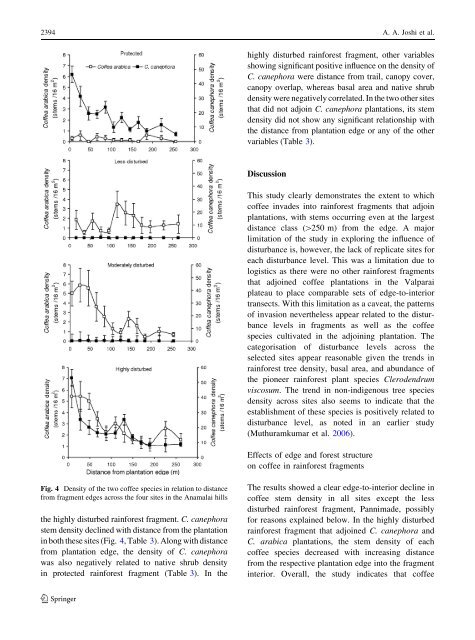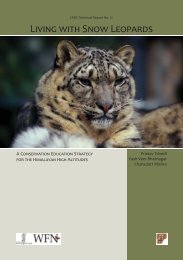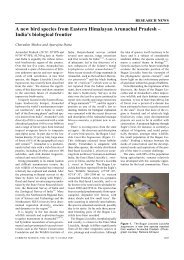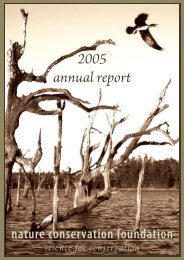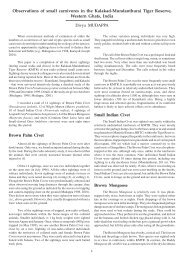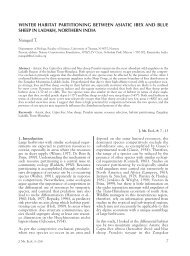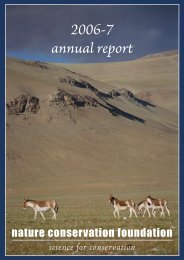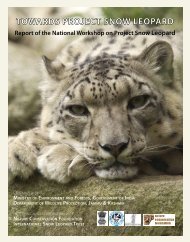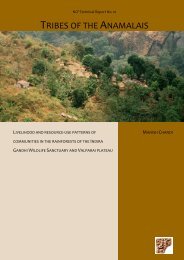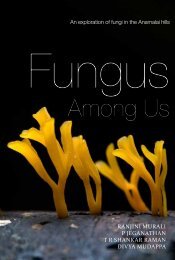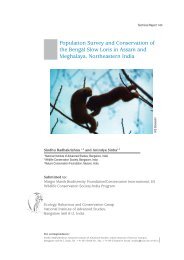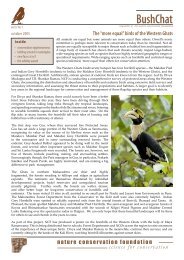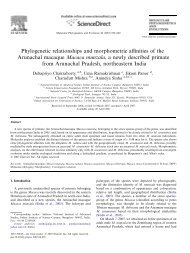Joshi Mudappa Raman - Nature Conservation Foundation
Joshi Mudappa Raman - Nature Conservation Foundation
Joshi Mudappa Raman - Nature Conservation Foundation
You also want an ePaper? Increase the reach of your titles
YUMPU automatically turns print PDFs into web optimized ePapers that Google loves.
2394 A. A. <strong>Joshi</strong> et al.<br />
Fig. 4 Density of the two coffee species in relation to distance<br />
from fragment edges across the four sites in the Anamalai hills<br />
the highly disturbed rainforest fragment. C. canephora<br />
stem density declined with distance from the plantation<br />
in both these sites (Fig. 4,Table 3). Along with distance<br />
from plantation edge, the density of C. canephora<br />
was also negatively related to native shrub density<br />
in protected rainforest fragment (Table 3). In the<br />
123<br />
highly disturbed rainforest fragment, other variables<br />
showing significant positive influence on the density of<br />
C. canephora were distance from trail, canopy cover,<br />
canopy overlap, whereas basal area and native shrub<br />
density were negatively correlated. In the two other sites<br />
that did not adjoin C. canephora plantations, its stem<br />
density did not show any significant relationship with<br />
the distance from plantation edge or any of the other<br />
variables (Table 3).<br />
Discussion<br />
This study clearly demonstrates the extent to which<br />
coffee invades into rainforest fragments that adjoin<br />
plantations, with stems occurring even at the largest<br />
distance class ([250 m) from the edge. A major<br />
limitation of the study in exploring the influence of<br />
disturbance is, however, the lack of replicate sites for<br />
each disturbance level. This was a limitation due to<br />
logistics as there were no other rainforest fragments<br />
that adjoined coffee plantations in the Valparai<br />
plateau to place comparable sets of edge-to-interior<br />
transects. With this limitation as a caveat, the patterns<br />
of invasion nevertheless appear related to the disturbance<br />
levels in fragments as well as the coffee<br />
species cultivated in the adjoining plantation. The<br />
categorisation of disturbance levels across the<br />
selected sites appear reasonable given the trends in<br />
rainforest tree density, basal area, and abundance of<br />
the pioneer rainforest plant species Clerodendrum<br />
viscosum. The trend in non-indigenous tree species<br />
density across sites also seems to indicate that the<br />
establishment of these species is positively related to<br />
disturbance level, as noted in an earlier study<br />
(Muthuramkumar et al. 2006).<br />
Effects of edge and forest structure<br />
on coffee in rainforest fragments<br />
The results showed a clear edge-to-interior decline in<br />
coffee stem density in all sites except the less<br />
disturbed rainforest fragment, Pannimade, possibly<br />
for reasons explained below. In the highly disturbed<br />
rainforest fragment that adjoined C. canephora and<br />
C. arabica plantations, the stem density of each<br />
coffee species decreased with increasing distance<br />
from the respective plantation edge into the fragment<br />
interior. Overall, the study indicates that coffee


